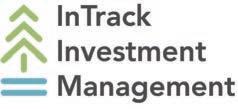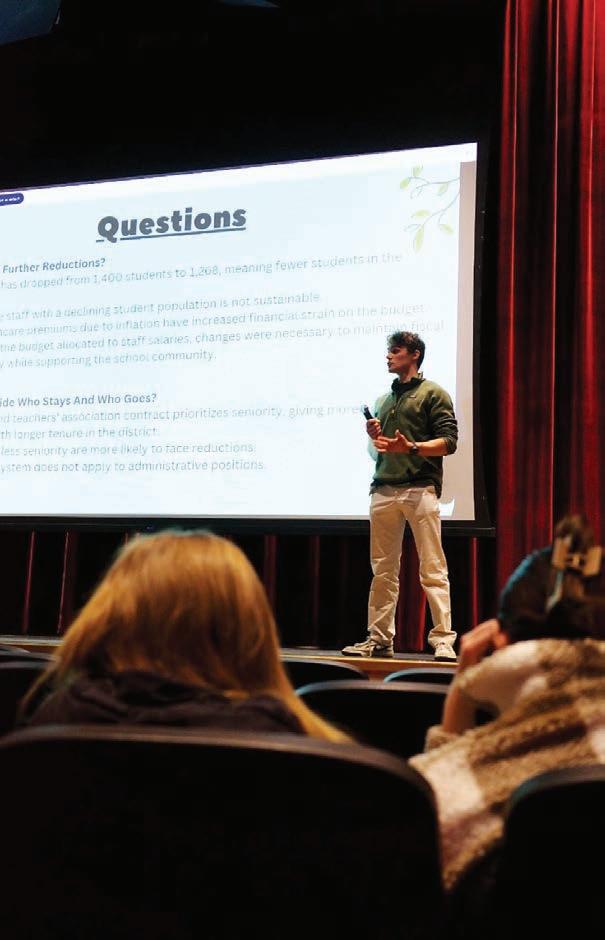Food for thought
Page 7



BY BRIANA BRADY

Page 7



BY BRIANA BRADY
BRADY STAFF WRITER
For the last few years, a family of beavers has made a home in Geprags Community Park in Hinesburg, and they’ve been renovating.
A pond has sprung up behind their dam. Plant life has flourished. Fish have returned. And, according to Bob Hyams, a Hinesburg resident and owner of Riverscape Ecology, the surrounding wetland is now abating phosphorous at a rate higher than some human interventions.
The positive impact of the beavers at Geprags that Hyams has observed complements grow-
ing scientific knowledge about how beavers can help reconnect floodplains, abate phosphorous and ultimately revitalize the ecology of struggling wetlands.
During a presentation to Vermont legislators this month, Hyams put forth a proposition: the state should start paying landowners to manage beavers on their land.
Vermont has known about the excess phosphorous in the Lake Champlain watershed for years. As a necessary nutrient for plants, phosphorous is common in agricultural fertilizer. In an agricultural state like Vermont, that has meant phosphorous runoff from agricultural operations into the water

system. However, although it helps plant growth, when in excess in waterways, phosphorous can cause water quality issues related to algae.
The state has been trying to address the phosphorous levels for years. Back in 2002, they established a plan to try to reduce the levels. However, when the EPA assessed Vermont’s plans in 2011, they mandated that the state take even greater measures, setting a timeline for the state to start in 2016.
“And the U.S. EPA says, Vermont, you got clean up Lake
See BEAVERS on page 13
BRIANA BRADY STAFF WRITER
Many people, if you asked them, probably couldn’t give a detailed explanation of how their school district’s budget works. School funding in Vermont is complicated. There’s a multi-step journey between a local school board setting a funding target, a superintendent putting together a budget proposal, calculating state-level tax assessment and student weighting and then voting on all that.
It’s difficult to even write a sentence about.
Not for Zoe Epstein.
A junior at Champlain Valley Union High School, Epstein has spearheaded an effort with six other students to learn the ins and outs of their district’s budget. After learning about it themselves, they’ve worked to explain it to their peers. Over the last month or so, the group has reached every member of the firstyear and senior classes as well as a few groups of sophomores and juniors.
Their goal? Make sure their peers understand the budget and feel empowered to participate. Epstein, in her second year as a student representative to the school board, first had the idea in December after she sat through a

budget presentation at a meeting.
“I went home, and I was like, students need to be a part of this conversation,” Epstein said.
When she thought about what form that would take, Epstein was inspired by a discussion format she’d participated in at school. For the last few years, CVU has been teaching its students through the Harkness Method, a style of classroom discussion that promotes student led discourse as the center point of learning.
Brad Miller, the social studies teacher leading the effort to integrate the Harkness Method at the school, was the first person Epstein talked to about running information sessions for students.
“What can we do to mimic a conversation about a book in an English class, but about the budget material? How can we have that same conversation about something that is not literature?” Epstein said she asked Miller.
After Epstein met with Miller and school principal Katherine Riley, superintendent Adam Bunting went to the student council, asking if students might be interested in joining Epstein on a budget working group. Six students answered the call: senior Patterson Frazier, juniors Jack

LIBERTY DARR STAFF WRITER
The Charlotte Energy Committee is making the case to bring more green energy initiatives to the town and now, more than ever, is the time to do it, members said.
The town’s selectboard approved — although not unanimously — hiring a consultant proposed by the group to help the committee study what this could look like for the town. A recent proposal by the committee outlines a series of steps related to the planning, design and implementation of energy system modernization at the town’s facilities.
“Essentially, we looked at the town plan, what our goals are for energy, and also took that in context of what’s going on in the world with legislation changing and things like that. And it drove us down this path to put something together to potentially act on,” energy committee member Jim Hodson said.
The word “energy” is used roughly 340 times in the 2019 Town Plan and is baked into nearly all aspects of the plan, which mandates the town seek to minimize energy use in private, public and commercial buildings and work toward “zero net energy” use in all sectors by 2050.
“Energy planning will be incorporated into all planning efforts, most notably those related to land use, transportation, healthy communities and sustainability,” the plan reads.
A first step in a potential three-phase project now proposed by the committee is for GreenEdge Energy Solutions to conduct a comprehensive audit of current energy consumption, generation, and building energy systems that make up the town’s several municipal buildings and facilities.
After that, the team could make recommendations to the selectboard for the possible redesign of municipal building energy systems using electric heat pumps to eliminate fossil fuel consumption or implementing solar generation systems to be located on town properties.
“There’s no cavalry coming,” Hodson

said. “It’s going to happen town by town and I hope that we could be a leader in Vermont and take this model and maybe go to other towns as well if the numbers work out.”
Not only have some state regulations shifted regarding net metering with a new bill, Act 179, but federally, the Trump administration creates uncertainty in receiving federal incentives.
Trump has, during his early days in office for a second term, notified the United Nations that the United States would be withdrawing from the Paris climate agreement, a pledge signed by nearly 200 countries in 2015 to reduce greenhouse gas emissions.
On Monday night, selectboard chair Jim Faulkner asked, “Does it make sense today with the way that the actions taken by the federal government on these projects?”
Hodson was clear that the potential to lose federal funds and incentives for energy projects like this creates a level of uncertainty for the committee but said work on the project began before the election and, as of now, the committee still has time.
“At this point, it’s kind of, if not now, when?” Hodson said.
The committee has already applied for Certificates of Public Good — documents issued by the state Public Utility Commission that authorizes a company or town to build energy generation facilities — for town properties that could host a solar array, although they do not bind the town to any decisions.
According to the scope of work, the work for the study and analysis phase of the project will cost the committee $4,000, which they have secured through a Municipal Energy Resilience Program state grant.
Once completed, the consultant and the committee will need to come back before the selectboard for approval to move forward with drafting a request for proposals for any infrastructure project. Should the town decide not to move forward with the project after that has been completed, the town is liable for roughly $8,000.
If the town moves through all phases, the fee to the consultant is $19,000, payable upon completion of the project.
The committees current work is intensifying what the town has already done as a commitment to combatting climate change.
The $3 million town garage built in 2023 was equipped with a solar array on the roof.
A selectboard vote to accept the scope
of work passed 4-1 with Faulkner casting the lone vote against, voicing concern over the monetary aspects of the project.
“We’re early on in this,” Hodson told the board. “There’s a lot we don’t know, but the thumbnail looks very positive. We really want to get feedback along the way and establish the rapport to be able to do that.”
Kelly Devine
Kelly Devine, an incumbent on the Charlotte Selectboard, is running for re-election. Here is her announcement.
My commitment to Charlotte is to run a positive campaign based on respect and solutions, one free from negativity. I believe in uplifting our community, not tearing others down.
We all know these are uncertain times, both nationally and at the state level. Charlotte is a small and very special town. My hope in the next year is that we come together and support it as we navigate these rough seas. Our world is facing too much division, and the last thing we need is more of it in our own backyard.
unprecedented hurricane damage, rebuilding Spear Street, a new town garage, and replacing our longtime town administrator.
The work I’m proudest of:
• Playing a key role in the hiring of Town Administrator Nate Bareham.

Kelly Devine
My name is Kelly Devine and I’m running for re-election to the Charlotte Selectboard.
A little bit about me. I’ve lived in Charlotte for nearly 20 years, and raised my two sons here. I led the building of a cooperative community off Greenbush Road. I’m proud of the fact that we conserved 116 acres of land and gave a town trail easement. I’ve been a Planning Commissioner. I have worked in local policy for 17 years, focusing on areas like budgets, housing, and tax policy.
During my two years of service on the Selectboard, we dealt with several emergencies: a vote against the town budget,
• Working with Town Administrator Bareham to improve town processes.
• Making Selectboard meetings more efficient, including introducing consent agendas.
• Working to address the significant damage to Spear Street following the Hurricane Beryl flooding. Spear Street is scheduled to reopen in April. In my next term, if elected, I plan to focus on the following:
• Creating a capital budget that will ensure that our town buildings, parks, trails, and other amenities are repaired and well-maintained; including supporting a new bath house.
• Improving the town’s purchasing policy to give both the Town Administrator, and Town Committees more authority within the budget.
• Creating a robust public process to help inform The next Town Plan.
• Continuing to keep town budgets balanced and spend tax dollars wisely.
• Continuing to improve the efficiency, openness, and inclusivity of town meetings.
I hope you’ll consider voting for me on or before Tuesday, March 4th. I’m happy to talk. Email me at kelly4charlotte@ gmail.com.



MIKE DONOGHUE CORRESPONDENT
Former Hinesburg Police Chief Anthony Cambridge said there is a “smear campaign” against him in his former town of employment. Meanwhile, he has missed two start dates as Richmond’s new police chief, according to the Richmond town manager.
Cambridge was initially scheduled to start in Richmond on Feb. 18, but town manager Josh Arneson announced during a selectboard meeting that night that Cambridge did not begin work. Arneson said Cambridge was given a new start date of Feb. 24 but was delayed again and is now due to start next Tuesday, March 4.
Arneson gave no explanation for the two delays when asked.
Cambridge, in a phone interview Monday,
said the delay was on Richmond’s end and he has been ready to start work since last month. He said he knows of no local, state or federal investigation into him that would delay his start.
“I passed a two-month long background check in connection with my application for the job in Richmond. My personnel file does not contain any documents showing concerns,” he said. “No charges were ever brought against me.”
Hinesburg Town Manager Todd Odit said this week he received word from at least two people who were concerned Cambridge had shredded some papers before he finished his job.
Cambridge said he did shred some docu-
See CAMBRIDGE on page 4
BRIANA BRADY STAFF WRITER
While most of the races in Hinesburg this year involve incumbents running for their current seats unopposed, come Town Meeting Day, Hinesburg will also see a couple contested races and newcomers.
If you haven’t had a chance to check in before now, here’s what you’ll see on your ballot on Tuesday. Voting will take place from 7 a.m. to 7 p.m. on March 4 at Hinesburg Town Hall.
The budget put forward by the selectboard for the 2025-2026 fiscal year is $5.47 million, with $4.4 million coming from property tax revenue. Voters will also decide whether to allow retail cannabis sales in Hinesburg.
In elections:
• Incumbent Dennis Place is running unopposed for another two years on the selectboard. This will be his third term.
• Todd Portelance is challenging incumbent Mike Loner for a three-year term on the selectboard. Loner was first elected in 2020.
• Incumbent Frank Twarog is running for another 1-year term as town moderator.
• Tom Giroux is running for another three-year term on the cemetery commission.
• Heather J. Roberts is running to return to the board of Peck Estate trustees.
• Keith A. Roberts is running unopposed to keep his seat on the Champlain Valley school board.
There are three three-year terms open on the Carpenter-Carse Library board of trustees:
• Marianna Holzer is the only incumbent running for one of the three open positions. Holzer has been on the board since 2011.
• The newcomers to the race are Katie Bailey Martin, Victoria Burns, Dani Fuoco, Paula Haskell, and Linda Segovia Wise
LIBERTY DARR
STAFF WRITER
Charlotte voters have a lot on the docket with Town Meeting Day approaching, especially with some important votes that could change how the town handles the annual tradition for the years to come.
Charlotte is holding hold two separate days for people to cast a vote, both in person on Saturday, March and by Australian ballot on March 4.
Voters Saturday, starting at 9 a.m. at Charlotte Central School, will be asked to approve a $4,265,990 municipal budget for the fiscal year that runs from July 1, 2025, to June 30, 2026. The selectboard and town clerk Mary Mead expects that more than $2.5 million to pay for expenses will come from taxes and more than $1.7 million will come from other revenue sources the town collects.
In other articles conducted in person
Saturday:
• Deciding whether future votes on the budget and all other public questions should be done by Australian ballot in the future, potentially doing away with in-person Town Meeting Day altogether.
• Consideration of adding $62,000 to the town trails reserve fund, in addition to the town budget.
• Consideration of adding $40,000
See CHARLOTTE on page 5
One of the candidates for the Carpenter-Carse Library board of trustees is Katie Bailey Martin. A story last week referred to her as Katie Bailey.





• Stroll through the Grand Garden Display filled with flowering bulbs, shrubs, trees, and water features!
• Shop the Flower Show Marketplace with over 100 vendors related to horticultural/gardening/home/ accessories.
• Choose from over 40 educational Seminars and Workshops on a variety of topics.
• Experts on-hand all 3 days to answer your gardening and landscaping questions.
• Family Activity Room: Come dig for worms, plant a flower, and make a craft and enjoy Magicians Without Borders & No Strings Marionette performances.
• Local bookstore with a great selection of books to choose from.
• The Federated Garden Clubs of VT, North District will present a National Garden Club Small Standard Flower Show: “The Story of the Garden.”
• Plant Sale at the end of the show on Sunday.
• Hours: Fri & Sat – 10am – 6pm; Sun









































continued from page 3
ments from his desk as he was leaving Hinesburg.
“I shredded the documents on the department shredder in the
middle of the common room with other officers present. I discussed the kinds of documents that I was shredding with the officers. I
Total incidents: 28
Feb. 18 at 6:33 a.m., police investigated an alarm activation at Champlain Valley Union High School.
Feb. 18 at 7:28 a.m., police investigated an alarm activation on Commerce Street.
Feb.19 at 6:58 p.m., an officer assisted with a tractor trailer unit that was stuck on Place Road West.
Feb.19 at 9:55 p.m., police conducted a welfare check on Texas Hill Road.
Feb. 20 at 10:33 a.m., an officer assisted first responders with a medical emergency on Thunder Drive.
Feb. 20 at 4:23 p.m., police conducted a welfare check on North Road.
Feb. 20 at 4:52 p.m., an officer helped South Burlington police locate a stolen vehicle on Hollow Road.
Feb. 20 at 5:01 p.m., police investigated suspicious activity on Commerce Street.
Feb. 21 at 7:00 a.m., police investigated an alarm activation on Ballard’s Corner Road.
Feb. 21 at 8:00 a.m., officers assist-
ed Hinesburg Fire Department with an emergency on Texas Hill Road.
Feb. 21 at 9:09 a.m., officers assisted Hinesburg Fire Department with an emergency on Commerce Street.
Feb. 21 at 3:58 p.m., police investigated 911 hangup on Birchwood Drive.
Feb. 24 at 7:53 a.m., police investigated a report of disorderly conduct on Ballard’s Corner Road.
Feb. 24 at 11:34 a.m., an officer responded to a three-car motor vehicle crash on Route 116.
Feb. 24 at 2:24 p.m., an officer responded to St. George to assist state troopers with a motor vehicle crash.
Feb. 24 at 7:00 p.m., an officer assisted first responders with a medical emergency on Richmond Road.
Feb. 24 at 8:51 p.m. police investigated a parking problem on Commerce Street.
Note: Charges filed by police are subject to review by the Chittenden County State’s Attorney office and can be amended or dropped.
Serving the community of Charlotte & Hinesburg A publication of Vermont Community Newspaper Group LLC thecitizenvt.com
Advertising Wendy Ewing wendy@shelburnenews.com (802) 238-4980
Advertising Director Judy Kearns judy@otherpapersbvt.com (802) 734-2928
Editor Tommy Gardner tommy@stowereporter.com (802) 253-2101 x25
Staff Writers
Aaron Calvin Liberty Darr
Patrick Bilow Briana Brady
Production/Design
Stephanie Manning stephanie@shelburnenews.com
Kristen Braley kristen@stowereporter.com
shredded the documents because they contained personal information about members of our community,” he said in an email statement Monday.
It was unknown if the shredding was in compliance with Vermont’s Public Records Law, which has strict retention provisions.
“I am disturbed by the smear campaign taking place in Hinesburg. I abruptly quit my position as Hinesburg Chief of Police because I already had a position in Richmond starting in a few weeks, and I could not tolerate the consistent and sustained efforts to undermine me,” Cambridge said in the statement. “I believe that I was and am a highly effective Chief of Police.”
Cambridge had served as both police chief in Hinesburg and was filling in for Richmond, which has been without a chief for more than a year. He said he wanted to focus his police career in Richmond, where he lives. Richmond hired him as chief in January with a starting salary of $99,958 and a $3,000 bonus because he lived in town.
Richmond also agreed to provide him a take-home police cruiser with related costs.
Since Cambridge’s hiring was announced in January, the Richmond Selectboard has had a series of closed-door meetings this month to discuss personnel and the police department.
Last week, the board made three motions to go into executive session at its regular meeting. The items to discuss were “update
on police department hiring,” “discussion of personnel issue,” and “evaluation of a public officer.”
In each case, the board came back into public session, took no action and moved on to the next motion to go behind closed doors.
The selectboard also held a special meeting Monday night to discuss behind closed doors an “update on police department hiring.” It was the lone item on the agenda and lasted about 40 minutes. No action was taken.
The Hinesburg Police Department continues to lose personnel, with Sgt. Brett Flansburg leaving to join the Vergennes Police Department as a patrol officer on Monday. Vergennes police chief Jason Ouelette said Flansburg was willing to take less money and a lower rank.
Hinesburg has named officer Frank Bryan as interim police chief. Hinesburg now has only three full-time officers and town officials have said patrols will be limited, with nothing on weekends.
In addition to addressing remarks about him shredding documents before leaving Hinesburg, Cambridge volunteered one other complaint about him that he said was bogus — somebody had complained about department guns at his home.
“I was the armorer for the Hinesburg PD. I sometimes kept firearms at home for repair because that is where my tools were located. When I returned the firearms after resigning from Hinesburg
PD, I had one Hinesburg handgun at my home. That is it,” he said. “I had three Richmond firearms — two rifles and one handgun. I’ve never spoke to any officer or anyone regarding this matter, nor has it ever been suggested that it was a problem.”
In addition, Cambridge had been reported by Front Porch Forum in May 2023 to the town managers in both Hinesburg and Richmond for unusual activity, according to Michael Wood-Lewis, co-founder and CEO of Front Porch Forum. Wood-Lewis said multiple accounts had been created “by shared IP address, device identity and browser cookie data.”
He said postings were submitted to the Hinesburg and Richmond forums through the accounts, “all of which are linked in various ways to the accounts of Amy Cambridge and/or Anthony Cambridge.”
The complaint said several of the accounts submitted postings weighing in on local political issues.
“The accounts were particularly vocal around policing and racial equity issues,” Wood-Lewis said, adding the messages were supportive of the Hinesburg police chief on “heated local issues.
It was unclear how many actual residents may have seen the messages on Front Porch Forum. The complaint to Hinesburg and Richmond stated the forum had flagged 13 questionable accounts, including at least eight that had emails or addresses used by Anthony Cambridge or his wife, Amy.
General Manager Katerina Werth katerina@stowereporter.com
Billing inquiries Leslie Lafountain leslie@stowereporter.com (802) 253-2101
Advertising submission deadline: Friday at 5 p.m. advertising@thecitizenvt.com classifieds@thecitizenvt.com
Editorial submission deadline: Friday at 5 p.m. news@thecitizenvt.com
Calendar submission deadline: Friday at 12 p.m. news@thecitizenvt.com
Contact: 1340 Williston Road South Burlington, VT 05403 (802) 985-3091






Guest Perspective
John Castle
Gov. Phil Scott has provided his shock and aw-shucks proposal for rescuing taxpayers and claiming to improve education along the way. Finding renewed hubris with the “red wave” of new Republicans in the Statehouse and Democrats running scared, Gov. Scott is seizing the opportunity with a misguided overhaul of our public education system.
It is time for Vermonters to defend our equitable, successful and essential public schools and local governance.
One of our most prized institutions, public education, is under attack. Public education is the only aspect of government service that is enshrined within our Vermont Constitution. Public education is a public good and not an individual entitlement. We must promote our public schools as a foundation of our democracy and defend the democratic practices that are essential to fostering the public’s trust in our schools.
all while pursing the real goal of expanded school choice and privatization.
Not wanting to waste a crisis, the administration moved quickly to unveil a proposal, with strategically absent details, allowing them to speak in broad platitudes and obfuscate the goal of closing many of our community schools. The administration has strategically crafted a narrative with misleading data that discredits our current education system at all levels, arguing that the funding formula is too complicated, we are spending too much, our results are in the middle of the pack and our governance structure does not allow for strategic budgeting.
Ironically, the governor has chosen not to address health care, which is one of the largest cost drivers impacting school costs.
Immense pressures from both inside and outside Vermont are working to dismantle our public education system and shift to a privatized approach. The playbook is clear: discredit, defund, dismantle.
We cannot be fooled by a sales pitch that promotes a questionable funding formula, out-ofscale governance restructuring and centralization of authority with the secretary of education,
continued from page 3
to a capital fund to build a new bathhouse at the Charlotte Town Beach, also in addition to the town budget.
• Authorizing using $5,000 from the trails fund for trail maintenance.
On Tuesday, in elections by Australian ballot:
• Hinesburg and Charlotte residents will be asked to vote on a $102.7 million Champlain Valley School District budget.
• Selectboard two-year term:
A better plan is to keep more public dollars in public schools.
The governor is now offering $77 million in one-time money to buy down tax rates as an inducement to his goal. The use of one-time funds to reduce tax rates is not typical for traditionally conservative public officials.
This past year, a confluence of factors conspired to result in double-digit increases in property taxes for many Vermonters. We have reasonable means to address some cost drivers and provide tax relief while we consider long-term systemic changes to ensure financial sustainability and effective delivery of high-quality public education.
Ironically, the governor has chosen not to address health care, which is one of the largest cost drivers impacting school costs.
All this is articulated with the promise to reduce costs and achieve greater results, when the reality is Vermonters will have less say and schools will have fewer resources. The administration even discredits our local school board members who are stewards of our public schools and make tough decisions continually in balancing the needs of students and the impact on taxpayers.
It is now evident that the administration’s plan is to increase the flow of public funds into independent schools. Why else would the administration set the stage for widespread closure of small, rural schools, yet say nothing about the 86 approved independent schools, receiving public dollars, with the majority having fewer than 50 students? It is hypocrisy.
In addition, we should be concerned with a “student centered” funding formula that allows funding to follow the child in a new free market educational system. The proposed foundation formula, where property wealthy communities have the advantage to raise more funds, is not in accordance with our state constitution, as defined by the 1997 Brigham decision.
Our public schools, run by local citizen school boards, are not to blame for our financial challenges, as the administration would have us believe. A five-district approach will create large bureaucracies that are removed from our schools and communities, diminish public trust in public education and provide a pathway for increased privatization.
By removing our local democratic engagement in the governance of our schools, there is no collective voice to advocate for our community schools’ needs
and, ultimately, their existence. Our schools are public schools, not government schools. Our practice of local responsibility is a core democratic value and asset, not something to be dismissed.
Given the chaos in Washington, greatly diminished support for public schools, and potential loss of federal funds, now is not the time to destabilize our public education system in Vermont.
We are already seeing many school boards make substantial reductions for FY26, as a result of the return of the excess spending threshold in the budget process. The Legislature needs to find reasonable solutions to cost containment and tax relief while
also considering much-needed strategic investments, missing from the governor’s plan, such as school construction aid, teacher workforce development, and practices such as the “community schools” approach, which has demonstrated a positive return on modest investment.
Ultimately, Vermont needs to continue to invest in and defend our public education system.
John Castle is the former superintendent of north country supervisory union, executive director of Vermont Rural Education Collaborative, and serves on the Commission on the Future of Public Education.
Kelly Devine versus JD Herlihy
• For a three- year seat: Lee Krohn, unopposed
• Auditor, three-year term: Richard Mintzer
• Cemetery Commissioner, three-year term: Jessie R. Bradley
• Cemetery Commissioner, two years of a three-year term: Peter Demick
• Cemetery Commissioner, one year of a three-year term: Lisa Hauenstein
• Library trustee, five-year
term: Hylah Patton
• Delinquent tax collector: Mary Mead
Also by Australian ballot, voters will be asked to approve a charter that would ensure all future changes to land use regulations be voted on by ballot. That request was spearheaded by two residents who petitioned over 250 of their neighbors to sign on to the change. A copy of the proposed charter change is available at the town clerk’s office.
Guest Perspective Walt Amses
Vice President JD Vance found himself on the horns of a dilemma last week when he momentarily couldn’t make up his mind in which direction to genuflect, toward the Vatican or the White House.
After converting to Catholicism in 2019, the Veep explained in an interview with The American Conservative that he and the church were simpatico: “I saw a real overlap between what I’d like to see and what the Catholic Church would like to see. I hope my faith makes me more compassionate to identify with people who are struggling.”
Well, after Vance’s short, strange trip to Europe we can certainly uncheck that box.
The vice president’s visit was about as well received as one of Elon Musk’s ketamine-addled, teenage miscreants making knee jerk decisions about the future of life on earth.
cede moral authority to the White House.
Vance’s idea of the faith and the pope’s response prompted Catholic writer Elizabeth Bruenig to suggest that a hallmark of the Christian faith was “the decision to serve the stranger, the refugee and the foreigner with charity” and any government crackdown on such work was a threat to Chris tian practice itself, threatening to “reshape it into something else altogether.”
“What is built on the basis of force and not on the truth about the equal dignity of every human being begins badly and will end badly.”
— Pope Francis
Excoriating European allies over the “enemy within,” advocating hate speech as free expression and parking his purported compassion at the door to quote Catholic chapter and verse in what New York Magazine termed “a theological defense of an ‘America First’ approach to immigration matters,” Vance expounded upon the early church concept of ordo amoris or “rightly ordered love” in a Fox News conversation with Sean Hannity, suggesting “you love your family, and then you love your neighbor, and then you love your community, and then you love your fellow citizens in your own country and then after that you can focus and prioritize the rest of the world.”
Almost immediately, the vice president’s mischaracterization of the Catholic tenet to provide religious cover for the administration’s ghastly immigration policies got an extraordinary clap back from the ailing, hospital bound, 88-year-old Pope Francis, who, in no uncertain terms, pointed out that Rome is not about to
Although Vance’s dispute with the pope over Catholicism seems an absurdly obvious losing prop osition, we should remember the vice president is merely the point man for a much larger MAGA expeditionary force dedicated to reshaping Amer ican Christianity. Since the inauguration, President Donald Trump has effective ly defunded religious groups providing life saving interven tions to many of the most vulner able people in the world. A confederation of Catholic relief agencies, Caritas International, warned that the cuts are “catastrophic” and that the “ruthless and chaotic” way they were carried out “threatens the lives and dignity of millions.”
Any American with a shred of empathy should be mortified that our country has enlisted the world’s wealthiest man to eliminate funding for the basic life-saving needs of the world’s poorest, most vulnerable people. But empathy is no longer a given, particularly in Christian Right circles, where the accumulation of power outweighs any altruistic endeavor, and that power is used to impose its will on other Christian organization it deems “too woke” or opposed to the presidential agenda.

The Citizen welcomes “50’s Child” to its feature pages this week. Drawn by Shelburne’s Paul Laud, the strip depicts the trials and travails of an aging boomer (like Paul) in a techno-centric, live-streaming world.
causes they would otherwise reject.”
Writing in the New York Times, David French, a Christian who opposes the MAGA agenda, laments “The Strange Spectacle of Christians Against Empathy,” citing a number of examples that conflate empathy with what sounds like a preposterous conspiracy theory where progressives “emotionally manipulate
Allie Beth Stuckey has written a best-selling book, “Toxic Empathy: How Progressives Exploit Christian Compassion,” wherein you will learn, for instance, that responding to the foreign aid shutdown and stop-work orders by discussing how children might suffer or die is exhibiting toxic empathy. A right-wing theologian, Joe Rigney, is publishing “The Sin of Empathy: Compassion and Its Counterfeits” this month.
Modern evangelicals endorsing the notion they need to be tricked into caring about the horror children around the world continue suffering daily says all you need to hear about the state of Christianity
that “he was anointed by God,” evangelicals voted overwhelmingly for the man who sits in the Oval Office facilitating revulsion with every flick of his Sharpie.
With the demonization of empathy, fundamentalists are now free to believe he can do no wrong and consequently, if his decisions cause pain, suffering or death, he is the authority. What he does must be good simply because he did it.
The president — evidently channeling either Nixon or Napoleon — claimed as much in a chilling social media post, saying: “He who saves his country does not violate any law.”
Pope Francis remains hospitalized midweek, being treated for
pneumonia in both lungs, his prog nosis uncertain. He’s fragile and pushing 90. Having dodged health issues for years, he may not make it. But if he doesn’t, Christians everywhere should remember how he went out. A giant among dwarves. He gets the last word:
“Mass deportation is a ‘major crisis’ ... an effort to apply brute force to a global migration trend that calls for sensitivity and compassion,” the Pope said. “What is built on the basis of force and not on the truth about the equal dignity of every human being begins badly and will end badly.” Amen.
Walt Amses is a Vermont writer.
ETHAN WEINSTEIN VTDIGGER
One moment helps crystallize for Harley Sterling the importance of providing free school meals.
Now the school nutrition director for the Windham Northeast Supervisory Union, Sterling remembered one morning when Vermont still used a needs-based meal system, rather than giving every student free food.
Sterling had prepared a buttermilk pancake breakfast and watched a student make a packed plate piled with pancakes and fruit.
Suddenly, the student “turned white as a ghost,” Sterling recalled, and said, “I just remembered I’m not supposed to get this because my mom started working.” According to Sterling, the student left their full plate on the counter and took off without eating breakfast, because he no longer qualified for free meals.
For Scott Fay, director of food services in the Essex Westford School District, the proof is in the cultural shift he’s seen since the universal school meals program began during the Covid19 pandemic. There are simply more students eating breakfast and lunch, and he’s able to make better food.
“Our cafeteria was kind of like a ghost town in the mornings,” he said. “Now, our cafeteria is chockfull of kids. It’s just a beautiful community to see that wasn’t there before.”
Although universal school meals started as a fully federally funded program in Vermont, the Legislature voted in 2023 to continue the initiative indefinitely, committing state funds to provide free breakfast and lunch to

students regardless of their household income.
Two years later, as part of his “education transformation” plan, Gov. Phil Scott has put the state’s universal school meals program on the chopping block. In his budget proposal presented last month, Scott recommended the state prevent any property tax increases next year by buying down rates and cutting spending — including the breakfast and lunch initiative.
According to Scott, nixing the program would help bring down education property taxes. He’s also argued the program is regressive.
“We should not be asking



lower income families to pay for meals for more affluent families,” Amanda Wheeler, a Scott spokesperson, said last week. “The proposal doesn’t roll back school meal support entirely, but instead, reverts to the needs-based construct that existed prior to universal school meals.”
Savings for families
As a line item, universal school meals would cost Vermont about $18.5 million next year, inside the more than $2 billion education fund. To cut it, Scott would need the Legislature’s sign off.
But legislative economists say
that providing meals to all students brings in significant federal dollars and reduces local spending in other ways, too. Were Vermont to revert to a needs-based approach, it would retain some money from Washington for school nutrition.
But the Vermont Agency of Education estimates that statewide, the universal meals program will draw down an extra $16.9 million in federal reimbursements next year.
Plus, the program’s supporters argue well-fed kids learn better, and creating equal access to food removes the stigma attached to receiving free meals based on a student’s economic status. Several
other states provide free meals as well, including Maine, Massachusetts and Minnesota.
Scott has said that if the Legislature is opposed to the repeal, lawmakers need to find an equivalent way to lower property taxes — something that hasn’t yet happened.
Meanwhile, support for the program appears strong and growing.
At the Statehouse last week, a group of anti-hunger advocates, school officials and lawmakers declared their intent to maintain the free meals initiative. House and Senate Democratic leadership have united in support of universal meals, and some Republicans have joined their colleagues across the aisle, too. In a straw poll, the House Agriculture, Food Resiliency and Forestry Committee voted unanimously to support the program last week.
According to advocates who spoke Thursday, the program costs about $30 per Vermonter annually. The Agency of Education says it saves families $1100 per student on the cost of food.
Rep. Heather Suprenant, D-Barnard, said that as a student in Randolph, she’d benefited from free meals.
“I didn’t fully understand the financial burden that was lifted from my dad when he didn’t have to worry about meals for me and my sister,” she said. “It’s a very full circle moment to be on the other side of this conversation, no longer a student, but as a policymaker, and I find myself asking, how is this program even up for debate?”
See SCHOOL LUNCHES on page 9


Jordanian pianist performs Middlebury concert
The Middlebury Performing Arts Series will welcome Jordanian Palestinian pianist Iyad Sughayer to the Mahaney Arts Center on Friday, March 7.
Sughayer’s Vermont debut, a solo concert in MAC’s Robison Hall, will feature Mozart’s “Adagio in B Minor, K.540,” Schubert’s “Drei Klavierstücke,” Sibelius’ “Six Impromptus” and Aram Khachaturian’s “Piano Sonata.”
Professor Emeritus of Music
Larry Hamberlin will introduce the evening’s music in a free pre-concert lecture at 6:15 p.m. in MAC room 125.
Tickets are $25 for the general public, $20 for Middlebury faculty/staff and alumni, $10 for youth and $5 for Middlebury College students.
Born in Amman, Jordan, Iyad Sughayer moved to the UK at age 14 to study at Chetham’s School of Music, the Royal Northern College of Music, and Trinity Laban Conservatoire of Music and Dance, where he won the College’s prestigious Gold Medal. Sughayer was named a ClassicFM Rising Star Artist, and “One to Watch” by International Piano Magazine.

Sughayer made his South American debut in Bogota, Colombia in October 2024, and is currently midway through his first professional tour of North America.
College students pitch ideas to Abraham LinkedIn
Eighteen Champlain College students will vie for exciting cash prizes and bragging rights when they deliver their most compelling 90-second pitch in one of three categories — job/internship seeker, advocate or entrepreneur — during the college’s 18th Annual Elevator Pitch Competition, March 2 at 2 p.m. at Alumni Auditorium, 375 Maple Street, Burlington.
Each student will pitch to a fictitious character, Abraham LinkedIn, in an elevator encounter. Celebrity judges will score the pitches based on both content and delivery, while the audience will have a chance to vote for the fan favorite in each category.
The Chittenden Asylum Seekers Assistance Network is looking for creatives —artists, poets, writers, sculptors, musicians, photographers — for its third annual April fundraising event, Arts for Asylum Seekers.
Creatives will produce and virtually share their work weekly or more often throughout the month. CASAN and the creatives will reach out to recruit sponsors who will donate to CASAN in exchange for receiving the creatives’ work through email or another online method.
Funds will be used to help
asylum seekers with housing, basic living expenses, transportation, legal fees, and other necessary support. The signup deadline is Feb. 28. For more information and to sign up to participate, visit casanvermont.org. Questions? Write to artsforasylumseekers@ casanvermont.org.
For a third consecutive year, the Children’s Literacy Foundation is challenging young writers in Vermont and New Hampshire to tell an original story using only two sentences. The theme of this year’s contest is “Love,” and entrants are encouraged to write about anything that evokes that sentiment for them.
CLiF’s Two-Sentence Story Contest is free to enter and open to all Vermont and New Hampshire children ages 12 and under. The winning submission in each of four age groups will be awarded a five-book mini-library curated to the recipient’s reading level and interests.
Last year’s contest, held in the weeks leading up to the total solar eclipse on April 8, asked children to “tell a story that takes place in the sky.” CLiF received over 900 entries from across Vermont and New Hampshire. In 2023, the inaugural Two-Sentence Story Contest challenged young writers to “tell a story about winter,” and drew over 700 entries.
For full contest guidelines, as well as free supplementary materials for educators and caregivers, visit clifonline.org/clifs2025-two-sentence-story-contest. Entries must be received by email or postmarked by March 14.


continued from page 7
Despite the governor’s preference, Vermont’s top school nutrition official, a director within the state’s Agency of Education, does not recommend cutting the program, arguing it’s cost effective.
VTDigger obtained an internal Agency of Education memo through a public records request, written before Scott publicly announced his recommended budget. In the document, Rosie Krueger, state director of child nutrition programs, told her superiors in the agency that the state stood to lose nearly $17 million in federal dollars next year by cutting universal school meals. She also predicted that many school districts would likely decide to continue the program on their own — as some had done previously — thus passing on costs to property taxpayers across the state.
“Schools would incur administrative costs of collecting and processing school meals appli-
cations each fall and collecting bills for lunch,” Krueger wrote.
“We would anticipate that affluent districts would return to relying on significant a la carte sales to stay viable, which are typically less healthy than the reimbursable meal options.”
Krueger also noted that a repeal would prevent the state from drawing down federal funds for summer and after-school meals — a new area targeted for expansion.
School nutrition leaders say that the state’s current program has allowed them to purchase more food from local farms and focus more on cooking from scratch. Without devoting resources to cash registers and accounting, more time is spent in the kitchen — and kids are reaping the rewards.
In the Windham Northeast district, Sterling said he’s more excited to go above and beyond in the kitchen knowing all students will benefit.
“You didn’t want to do all those special, extra things to really flaunt the programs when you
Discover how to break through barriers and step into your full potential as a leader. Clarity on how your beliefs impact your leadership Tools to shift from self-doubt to self-confidence
Actionable Strategies to lead with authenticity Wednesday, March 12, 9 a.m. to Noon 722 S. Main St., Stowe





knew a bunch of kids were being left out,” he said.
Both Sterling and Fay praised the program’s destigmatizing effects on kids and argued the universal school meals keeps money in the pockets of middle class families who need it.
Essex Westford went from spending 2% of its nutrition budget on local food to 17%, or about $170,000, according to Fay, purchasing beef, apples, bakery goods and maple syrup locally. The Agency of Education estimates schools buy $2 million in local food, a figure that continues to grow.
Asked what would happen if the universal school meals were repealed this year, Fay said the district has already budgeted assuming the program will continue.
“It’s not like we can turn on a dime,” he said. “I need software; I need staff.”
But more than that, Fay opposes getting rid of a program he sees as bringing many benefits to kids: “I don’t want to be part of that.”


























Sign up for our Friday EMAIL NEWSLETTER
Headlines and news sent directly to your inbox every Friday at 10 a.m.
Sign in and add your weekly newsletter: VTCNG.com/users/admin/mailinglist

LAUREN READ CORRESPONDENT
Champlain Valley 74, Rice 26: The Champlain Valley girls’ basketball team won its second game in a row, beating Rice on Sunday.
Zoey McNabb had 32 points to pace the Redhawks, while Rose Bunting had a double-double with 14 points and 10 rebounds.
CVU also got the win on Thursday, outscoring Essex 17-7 in the fourth quarter to pull away for the 43-39 win.
McNabb had 14 points to pace the Redhawks. Kaitlyn Jovell added nine points for CVU.
The Redhawks moved to 12-6 this season with the win.
After the first day of the Northern districts, held Monday, Champlain Valley was in first place in both the girls’ and boys’ races.
Through the slalom races at Cochran’s Ski Area, the CVU girls were tied with Rice.
Rachel Bialowicz paced the Redhawks with a third-place finish, Carly Strobeck was in fourth place and Heather Pelletier came in sixth place. Addie Bartley wrapped up the top CVU skiers with a 10th place finish.
On the boys’ side, Ray Hagios came in second place to lead the Redhawks, George Francisco finished in third place and Jack Thorley-Doucette came in eighth place. CVU sits in first place ahead of second place St. Johnsbury and third place Mount Mansfield.
The district competition wrapped up on Tuesday at Smugglers’ Notch with the giant slalom races. The race was held after press deadline.
Boys’
Champlain Valley 4, Colchester 0: Champlain Valley snapped its five-game losing streak with a win over Colchester in high school boys’ hockey Saturday.
Sawyer Wellman had two
goals and one assist for the Redhawks, while Jack Bryan added a goal and an assist. Hays Arnoldy and Jameson Yandow each chipped in with two assists.
Jesse McCray stopped 15 shots for CVU, who now have a 7-12 record.
Boys’ basketball
St. Johnsbury 62, Champlain Valley 45: Champlain Valley dropped its final game of the regular season, falling to St. Johnsbury on Saturday.
Luke Allen had 11 points for the Redhawks, who finish the regular season with an 8-12 record. Owen Scott chipped in with eight points.
Girls’ hockey
Rice 4, Champlain ValleyMount Mansfield 0: The Champlain Valley-Mount Mansfield girls ice hockey team saw its three-game win streak snapped with a loss to Rice on Saturday.
The CougarHawks are now 7-11 with just one game remaining in the regular season.
Nordic skiing
After the first day of the Vermont Nordic skiing state championships on Tuesday, Champlain Valley sat in second place in the boys’ competition and third in the girls’ competition.
The second part of the race — the classic portion — was held on Tuesday at the Prospect Mountain Ski Center, after press deadline.
On the boys’ side, Will Wallace came in fourth place in the freestyle race to lead CVU and the Redhawks relay team came in second place.
The boys sit behind Mount Mansfield and looked to close the gap in the second day of competition.
Annalise Wood was the top finisher for the CVU girls, coming in fifth place. Ella McEntree came in seventh place and Charlotte Crum finished in eighth place.
The Redhawks finished Day 1 in third place behind leader Mount Mansfield and second place St. Johnsbury.

Jovell elevates, eyes on the prize, as part of a nine-point effort in last week’s win over Essex.

The business next door donates nearly twice as much as big-box stores and online retailers to local non-profits, events and teams.

The Outside Story
Emily Haynes
It’s a familiar sight in winter: An inkyblack raven soaring over a landscape white with snow. Though similar in appearance to the American crow, the common raven (Corvus corax) is distinguished by its large size, fluffy neck feathers and long, thick beak.
The ubiquitous raven croak can carry for more than a mile. It is throaty and rasping, unlike the American crow’s shrill caw. While the croak is the most recognizable call that ravens use, it’s far from the only one. These intelligent birds can make 33 different vocalizations, which express a whole range of meanings such as deterring a predator, defending a nest or communicating the presence of food.
Scientists at the University of Vienna in Austria concluded that ravens may even have theory of mind, meaning they’re aware of both their own and others’ thoughts, motivations and behaviors.
A raven’s intellect is essential in winter when insects, bird eggs, berries and other desirable foods are scarce. Ravens must be dogged in pursuit of the calories they need to make it to spring.
“Right now, they are trying to pack on protein and fat,” said Anna Morris, director of wildlife ambassador programs at the Vermont Institute of Natural Science, where she works with an ambassador raven named Stockbridge.
A raven is unlikely to turn up its nose at any opportunity to eat in winter. They’re regulars at compost piles and garbage cans.
“You see them a lot in urban areas this time of year,” Kevin Tolan, staff biologist at the Vermont Center for Ecostudies, said.
Carcasses, including those of animals killed by cars, illness or injury, are prized resources in winter. The carcass of a dead male white-tailed deer, for example, could offer more than 200 pounds of meat and fat, some of which a raven could store for leaner

times in a hidden reserve called a “cache.”
The trouble is, there’s no telling where a raven may come across a carcass, and odds are it could be in another raven’s territory. Adult ravens live monogamously in pairs, defending their territory from incursions by predators and other ravens, usually “vagrants” without their own territory.
Juvenile vagrants work together to make it through the lean months.
“You get these roving bands of teenaged ravens who are looking to exploit large ephemeral food sources, such as carcasses,” Morris said.
Young ravens puzzle through their first winter without the help of a mate and develop some wily tricks to make it through, as first documented by biologist Bernd Heinrich, professor emeritus at University of Vermont. Heinrich observed ravens emitting a loud yell at the site of carcasses — attracting their peers to join in on the meal.
Over the course of four winters, as described in his book “Ravens in Winter,”
Heinrich set carcass baits and observed the ravens’ behavior at them to see whether they were indeed communicating the whereabouts of food to their peers.
Paired ravens, Heinrich found, didn’t yell when feeding. In fact, 82 of the 91 ravens who arrived at the baits for four separate group feasts were either nonbreeding juveniles or subadults.
“The paired ravens are fully grown adults,” Morris said. “They’ve been through multiple seasons together. They’re a little bit more savvy about gathering food and food resources.”
Heinrich’s study showed that group feasting is a young raven’s game. The birds attracted to the carcasses were primarily juveniles without their own territory who, in surveillance flights, had successfully found a meal ticket. They understood that it was a risk to eat in another raven’s neck of the woods, so they called in back-up.
“All these ravens show up together at this food resource, they make a bunch of noise,

ILLUSTRATION
they attract other ravens, and therefore the group can overwhelm the defensive territorial pair,” Morris said.
This practice means that each teenage raven gets less to eat at any shared food resource.
“If you have to share your birthday cake with your 15 neighbors, you’re going to get less of it yourself,” Morris said.
But for birds who are still learning the art of foraging in winter — and who can’t yet rely on the help of a mate or the known resources of their own territory — it’s worth it.
Emily Haynes is a writer currently living in Washington, D.C. An avid birder and hiker, she loves exploring the forests of the Northeast. Illustration by Adelaide Murphy Tyrol. The Outside Story is assigned and edited by Northern Woodlands magazine and sponsored by the Wellborn Ecology Fund of New Hampshire Charitable Foundation: nhcf.org.














BUDGET
continued from page 1
Bryan, Eva Fewell, Emma Main and Chloe Ngu, and sophomore Willcox Elliot.
The group started meeting with Bunting and the district communications coordinator, not only to discuss how they wanted to approach the discussions with other students, but also to fill in their own gaps in knowledge about how school funding and budgets work.
In the process, the students came to a few conclusions: they wanted to have a presentation so everyone would start with some knowledge of the budget, they wanted it to be peer led and they wanted to encourage students to
take what they learned and share it with their families.
In the case of the seniors, they had an additional motivation: urging students over 18 to vote on Town Meeting Day.
“We’ve made a point not to tell them what to do,” Fewell said. “Make up your own mind, and if your family is not in the financial situation where you are able to vote for this budget, that is completely okay, and we get it, but here is some information.”
Their sessions covered a lot of information, breaking down how the state funding model works with Act 60 and Act 127. They explained what it meant that the



district would be cutting more than 38 full-time equivalent staff, and how that might affect class offerings or extracurriculars. They outlined exactly where that $103 million goes and why.
This is the second straight year Champlain Valley has made significant cuts to staffing. If the budget passes, the district will have reduced or eliminated 80 full-time positions over two years. Epstein and Fewell, who were both sophomores last year when that budget initially failed, said they worry that, if the budget doesn’t pass this year, they’ll see an even greater reduction in what the school can offer.

In their information sessions, the group not only covered the nuts and bolts of funding, but also the concerns their peers share with them. In a video they put together, different students stand in front the of the camera and answer from a selection of questions: What did you learn? What concerns you? What does the budget passing, or not, mean to you?


The video ends on one student, ninth grader Gus Roden, who sums up what many before him shared: “One thing I like about CVU is all of our amazing teachers, and I’m worried that, if the budget doesn’t pass, we’re going to lose them, and I really don’t want that to happen.”
Last week, all seven students presented their work to the school board. Each student explained why they got involved in the first place. One by one, they reiterated how important it was to them to fully understand the budget, to share that knowledge with others and to promote student voices in the conversation.
Epstein took the board through their presentation and showed a shortened version of the video, finishing with the group sharing their takeaways from the experience. They hope that not only will the students take budget information home to their families but that the selectboards or various committees in their communities might show the video to residents.
The reaction from the board was something close to awe.
“When we talk about student outcomes and we talk about performance data, people rarely think of what we just saw,” superintendent Bunting said at the end of their presentation. “And what we saw, to me, is what it means to be an informed citizen.”
continued from page 1
Champlain, right? They give you a bunch of money to do it, but we need to see results. So that was really the impetus for coming up with this functioning floodplain initiative,” Hyams said.
The functioning floodplain initiative aims to fund wetland and floodplain restoration. In measuring phosphorous abatement, Hyams said, the state uses floodplain reconnection as a proxy. That’s because floodplains and wetlands have been shown to act as phosphorous sinks, the plants that thrive in those environments absorb phosphorous from the water as it floods and settles into the ground.
When the beavers moved into Geprags a few years ago, Hyams saw an opportunity to observe the kind of impact beavers can have on phosphorous absorption as they interact with the landscape. According to Hyams, a lot of streams in Vermont suffer from incision, a process in which the streams straighten out and carve vertically down into the ground rather than curving through the landscape. This causes the velocity of the streams to increase, curbing the amount of water that gets
absorbed into the ground. Beavers, in building their dams, fight that process.
In the presentation he gave to the legislature, Hyams pulled up a map of Geprags from 2018. The stream moves through a brown landscape in a fairly straight line. Hyams then overlaid an image that was taken with a drone after three years of beaver activity. A pond flows out over the plain, plant life spreads out from the waterway.
“There’s habitat for everything,” Hyams said. Using the same methodology the state uses to measure floodplain reconnection, Hyams assessed that the beavers had precipitated 25-30 kilograms of phosphorous absorption, more than has been measured at manmade phosphorous absorption projects in the county. Hyams has estimated, using the information Chittenden County Regional Planning Commission has about its own projects, that the beaver’s work was worth about $750,00. The beavers did it for free.
Beavers have other ecological benefits beyond phosphorous absorption. In reconnecting floodplains, they also help with flood management. It might seem coun-

2024 AND 2029 NOISE EXPOSURE MAPS (NEMS) PREPARED FOR PATRICK LEAHY BURLINGTON INTERNATIONAL AIRPORT (BTV) ARE AVAILABLE FOR DOWNLOAD
The City of Burlington is announcing that the FAA has determined that the year 2024 and 2029 Noise Exposure Maps (NEMs) prepared for Patrick Leahy Burlington International Airport (BTV) were developed in accordance with the procedures outlined in Appendix A of Title 14, Part 150 of the Code of Federal Regulations.
The NEMs may be downloaded using the links on the website below. For further information, please contact Larry Lackey, Director of Planning, Engineering and Sustainability at 802-338-8106. Visit www.btvsound.com for the 2024 and 2029 Noise Exposure Map.

terintuitive that the minor flooding in wetlands helps prevent issues from major floods, but the ways in which wetlands provide winding streams slows water down, spreads it out, and helps it absorb into the ground.
Some of the projects in the state that seek to do floodplain reconnection use beavers as inspiration. Allaire Diamond with the Vermont Land Trust has looked at how beaver analogs — essentially, dams built by people — can help revitalize wetlands. She said finding space for actual beavers to do their work is something the state should explore.
“If we can just give them space to do their work and support them in whatever ways they need, then that feels like a really good use of our resources,” she said.
Diamond said there are plenty of places in the Vermont landscape where beavers could be managed without getting too close to human settlements.
For Hyams, it makes perfect sense to use some of the money the state has allocated for floodplain restoration to landowners managing beavers. The state already provides analogous funding for

things like river corridor easements or carbon credits. And, right now, there isn’t much incentive for landowners to keep beavers on their land — after all, they’ve long been understood as nuisances.
“I think the majority of people that take out beaver dams think they’re doing it as a public service,” Hyams said. “I just want the state once, one time, to pay landowners for the phosphorus reduction values that beavers created.”
Should the Legislature take on
TOWN OF CHARLOTTE REQUEST FOR PROPOSALS FOR MOWING AND LAND MAINTENANCE
February 14, 2025
The Town of Charlotte is seeking proposals from contractors for mowing and land maintenance on various Town lands and the Charlotte Little League ballfields. Supporting materials for this request (details, maps, and a bid worksheet) are available on the Town’s website at www.charlottevt.org/jobs
Sealed Proposals are due by March 10th, 2025 by 4:00 PM and must be delivered either:
By mail to:
Charlotte Town Office
“Land Maintenance Bid”
P.O. Box 119 Charlotte, VT 05445
By hand to:
Charlotte Town Office
“Land Maintenance Bid” 159 Ferry Road Charlotte, VT 05445 OR
Please direct any questions to townadmin@townofcharlotte.com

Hyams’ idea, the cost of doing that might start to look pretty attractive, and maybe, just maybe, landowners will start sending out invitations to beavers.

PUBLIC HEARING Hinesburg Development Review Board
Tuesday, March 18, 2025 7:00 pm
Suzi Vaccarelli & Phil Seeley: Final Plat Subdivision for a two-lot subdivision of a 2.1-acre property located at 201 Richmond Road in the Residential-3 Zoning District.
Jacob & Jennafer Thompson: Final Plat subdivision for a two-lot subdivision of a 14.24-acre property located at 223 Burritt Road in the Agricultural Zoning District.
The meeting will be both in person and remote. See meeting agenda on town website with details on how to participate.
















ANDREA KNEPPER UVM EXTENSION
By this time of the year, it may seem like winter will never end. Many of us are eager to start gardening knowing that spring is right around the corner. While we can’t make the calendar pages turn more quickly, we can get ready for the upcoming gardening season while having some fun with friends and neighbors by hosting a garden party.
Hosting a garden-themed gathering is a great way to start planning for the upcoming garden season, swap seeds, exchange houseplant cuttings and share favorite recipes using garden delicacies. Consider inviting all the green-thumbed friends in your life for a couple of hours of sharing, networking and fun.
• Plan your event: Make your guest list, including family, friends and neighbors. Many public libraries have spaces that can be reserved for gatherings if you are not able to host in your own home. If you are using a public space, consider posting your event so more people may be able to join in the fun.
• Organize your seeds to swap: Sort through your seed collection and set aside extras to share. Double-check to make sure they are in good condition and likely viable. If you are not sharing the whole seed packet, clearly label an envelope with all the critical information such as plant variety, planting, growing and harvest information.
• Organize a seed catalog order: Costs can add up when ordering gardening seeds and supplies. Bring seed catalogs and organize a group order to share larger packets of seeds and cut down on shipping costs. Even if no orders are placed, it is fun to see catalogs from new seed companies and all the different plant varieties available.
• Exchange houseplant cuttings: A number of houseplants are easy to propagate from cuttings. Some of the easiest to propagate in water are pothos, philodendron, Christmas cactus, pilea (Chinese money plant), geranium and spider plant. Snip a stem off any of these plants just below a node and place it in water. Within a couple of weeks, roots will form and the cutting will be ready to plant.
Promote your program in our Summer Camps issues for focused reach to a local audience of kids and parents as they make plans for the upcoming summer season. This advertising section captures the attention of summer camp and recreation seekers, making it the ideal place to outline your offerings and secure more early enrollments.
Publication Dates: March 6, April 3
Deadlines: Thursdays before each issue
Contact: Shelburne News/The Citizen at 802-238-4980, The Other Paper at 802-734-2928 or Stowe Reporter/News & Citizen at 802-253-2101 for information or to advertise your camp (ask about multi-paper and color deals).

Grab some seeds and some friends and start plotting your garden
• Share gardening know-how: A gathering of gardeners can be a tremendous resource. Brainstorm solutions for issues experienced in the garden, share tips and tricks and discuss successful pest control strategies. If you get stuck, you can submit your questions to the University of Vermont Extension Master Gardener Helpline at go.uvm.edu/gardenquestion.
• Garden delights: A fun way
to engage guests and lighten the responsibilities of the host is to organize a potluck. Ask your attendees to bring a snack or appetizer to share, preferably using ingredients that can be grown in the garden. Have copies of the recipe available to take home. Maybe there are seeds to share for the produce as well.
A winter garden party is more than a fun gathering. It’s a way to


strengthen your gardening network, share knowledge and build excitement for the upcoming gardening season. You will be sure to leave with new ideas and inspiration. Celebrate the joy of gardening and brighten the winter months by connecting with fellow gardeners.
Andrea Knepper is a UVM Extension Master Gardener from Bolton.


To learn more or reserve your space, contact us today!



